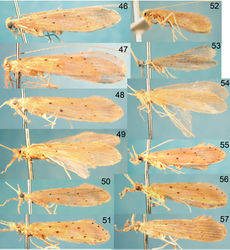Oecetis campana
| Notice: | This page is derived from the original publication listed below, whose author(s) should always be credited. Further contributors may edit and improve the content of this page and, consequently, need to be credited as well (see page history). Any assessment of factual correctness requires a careful review of the original article as well as of subsequent contributions.
If you are uncertain whether your planned contribution is correct or not, we suggest that you use the associated discussion page instead of editing the page directly. This page should be cited as follows (rationale):
Citation formats to copy and paste
BibTeX: @article{Blahnik2014ZooKeys376, RIS/ Endnote: TY - JOUR Wikipedia/ Citizendium: <ref name="Blahnik2014ZooKeys376">{{Citation See also the citation download page at the journal. |
Ordo: Trichoptera
Familia: Leptoceridae
Genus: Oecetis
Name
Oecetis campana Blahnik & Holzenthal, 2014 sp. n. – Wikispecies link – ZooBank link – Pensoft Profile
Diagnosis
Oecetis campana sp. n. is similar in size and general coloration to both Oecetis mexicana sp. n. and Oecetis constricta sp. n. It differs from either of these species in that the phallobase of the male, in lateral view, has its ventral margin nearly straight or very weakly arched (Fig. 6B), and thus more “bell-shaped” in overall appearance. Like Oecetis mexicana, the apex of the phallobase, in caudal view, is U-shaped, rather than “pinched.” In coloration it is slightly darker than Oecetis mexicana, and has larger forewing spots and more elongate setation along the costal margin. The ventral lobe of the inferior appendage forms an approximate right angle to the dorsal lobe, as compared to the distinctly obtuse angle in Oecetis constricta. Oecetis mexicana is variable in this respect. Oecetis campana is currently only known from a restricted region in Ecuador, but the existence of essentially identical forms from several locations suggests that it represents a distinct species. Based on their illustration, it seems likely that the specimen of Oecetis avara illustrated by Rueda Martín et al. (2011)[1] from Bolivia represents this species. Specimens typical of and referable to Oecetis mexicana are also found in Ecuador, and at one site were found together with Oecetis campana.
Adult
Forewing length: male (6.5–7.9 mm), female (6.5 mm). Color yellowish, about same color as Oecetis mexicana sp. n. Antennae whitish, annulations not evident. Forewing spots distinct and large; spot at base of discal cell largest, spots at base of other major wing forks nearly as large; veins of forewing chord widely spaced, either even spaced or s and r-m veins slightly closer; chord with small spots at juncture of major veins, those at opposite ends of chord larger; apical spots, at apices of major veins prominent, rounded, pigmentation extending beyond veins. Setae along veins in apical part of forewing elongate, semi-prostrate, laterally diverging. Fringe of setae along costal margin of forewing moderately dense, very elongate, nearly erect.
Male genitalia
Segment IX very short, with elongate setae along posterolateral margin. Tergum X with narrow, deflexed mesal lobe, apex of lobe lobulate, with small sensilla; lobe continuous basoventrally with short, paired lateral membranous projections. Preanal appendage moderately elongate, about 3 times maximum width, simple in structure, apical setae elongate. Inferior appendage with prominent rounded dorsal lobe and angularly projecting ventral lobe; ventral lobe moderately projecting, forming approximate 90° angle with dorsal lobe, posterior margin of ventral lobe, as viewed ventrally (Fig. 6E), angularly bent near base, linear or slightly concave from bend to apex of projection; basomesal projection weakly developed, scarcely protruding, with short, stiff setae; dorsal lobe with stout, mesally-curved setae on dorsal margin and stout, ventrally-curved setae on mesal surface. Phallobase very short, tubular, flared apically, ventral apex somewhat projecting, ventral margin, as viewed laterally, nearly straight or very weakly curved; ventral apex, as viewed caudally, U-shaped (Fig. 6C). Phallotremal sclerite prominent, basally forming short tubular collar, ventral margin projecting; asymmetrical lateral sclerite present, broadly rounded, not conspicuous.
Holotype
Male (pinned), ECUADOR: Zamora-Chinchipe: Río Chicaña, 9 km N Yanzatza, el 880 m, 20.xi.1990, O.S. Flint, Jr. (NMNH) (UMSP000208264).
Paratypes
ECUADOR: Napo: Pano, 580 m, 12.ix.1990, O.S. Flint, Jr. 1 male (pinned) (NMNH); Pastaza: Puyo, 1–7.ii.1976, Spangler, et al., 1 male (pinned), 1 male, 3 females (alcohol) (NMNH); Puyo, 8–11.ii.1976, Spangler, et al., 1 male, 1 female (alcohol) (NMNH); Puyo, 5.v.1977, P.J. Spangler & D.R. Givens, 1 male (alcohol) (NMNH); Puyo, 27 km N, Est. Fluv. Metrica, 4.ii.1976, Spangler, et al., 1 male (alcohol) (NMNH); Zamora-Chinchipe: 6 km E Zumbi, el 980 m, 21.ix.1990, O.S. Flint, Jr., 1 male, 1 female (pinned) (NMNH); Yanzaza, 15.vi.1976, A. Langley, et al., 1 male (pinned) (NMNH); Río Chicaña, 9 km N Yanzatza, el 880 m, 20.xi.1990, O.S. Flint, Jr., 9 males (pinned), 13 males, 5 females (alcohol) (NMNH) (UMSP).
Etymology
This species is named Oecetis campana, from the Latin for bell, in reference to the shape of the phallobase in this species, which has something of a bell-shape due to the apex being distinctly flared and the ventral margin very little curved.
Original Description
- Blahnik, R; Holzenthal, R; 2014: Review and redescription of species in the Oecetis avara group, with the description of 15 new species (Trichoptera, Leptoceridae) ZooKeys, 376: 1-83. doi
Other References
- ↑ Rueda Martín P, Gibon F, Israel M (2011) The genus Oecetis McLachlan in Bolivia and northwestern Argentina (Trichoptera: Leptoceridae) with new species and identification key for males of Oecetis species from Mexico, Central and South America. Zootaxa 2821: 19-38.
Images
|

